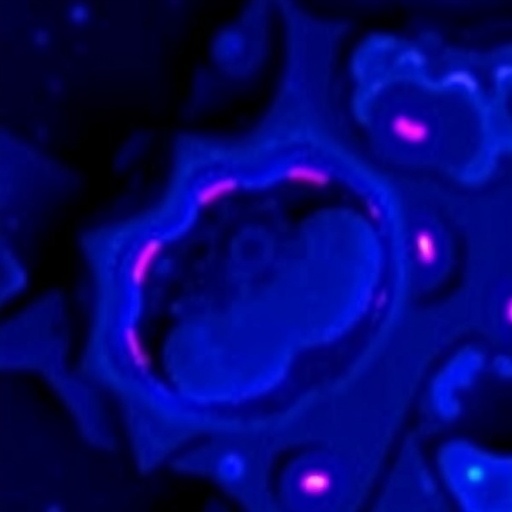In a groundbreaking development in the battle against ovarian cancer, recent research has identified SLC4A11 as a critical marker that could enhance therapeutic responses in patients. Conducted by a team led by Xiang Li, alongside notable contributors such as Jian Yuan and Feng Wang, the study published in J Ovarian Res presents a thorough investigation into how SLC4A11 can potentially alter the treatment landscape for those afflicted by this aggressive form of cancer.
Ovarian cancer remains one of the deadliest forms among gynecological malignancies, with a high rate of late-stage diagnosis. Traditional treatment approaches often emphasize surgery followed by chemotherapy, but these methods do not guarantee success for every patient. This shortfall underscores the necessity for novel biomarkers that can not only diagnose the disease earlier but also predict the efficacy of therapeutic interventions.
SLC4A11, a sulfate transporter belonging to the electrogenic sodium-coupled bicarbonate cotransporter family, has emerged as a potential linchpin in this area of research. The study reveals that SLC4A11 is upregulated in ovarian cancer tissues compared to normal ovarian tissues, suggesting that its expression levels correlate with tumor progression. The researchers leveraged advanced techniques, including RNA sequencing and immunohistochemistry, to substantiate their claims about SLC4A11’s significance in ovarian cancer pathology.
Furthermore, the study aims to elucidate the functional ramifications of SLC4A11 expression on therapeutic responses. In preclinical models, the team observed that increased SLC4A11 expression corresponds to enhanced sensitivity to certain chemotherapeutic agents. These findings present a compelling argument for the hypothesis that SLC4A11 may not only serve as a biomarker for therapeutic response but also as a target for future interventions.
The connection between SLC4A11 and chemotherapy sensitivity opens up avenues for personalized medicine, enabling tailored treatment plans based on individual patient profiles. By analyzing SLC4A11 levels, oncologists may soon be able to predict which patients will benefit the most from specific chemotherapy regimens, thereby optimizing therapeutic outcomes and reducing unnecessary side effects that come with ineffective treatments.
Beyond its role in treatment efficacy, the study also explores the mechanistic pathways through which SLC4A11 influences cancer cell metabolism. Preliminary data suggest that SLC4A11 may modulate ionic balance within the tumor microenvironment, which in turn affects tumor cell proliferation and survival. This groundbreaking insight could change the fundamental understanding of how ovarian cancer adapts and survives under therapeutic pressure.
Moreover, the research team anticipates that pharmacological agents targeting SLC4A11 could be developed, drawing from existing drug libraries to identify compounds that can modulate its activity. Such an approach could dovetail with current therapies to enhance their effectiveness, representing a significant leap forward in treating ovarian cancer.
In conclusion, this study by Li et al. underscores the importance of SLC4A11 not merely as a biomarker but as a potentially actionable target in the treatment of ovarian cancer. By bridging the gap between basic research and clinical application, this work paves the way for new treatment paradigms that promise to revolutionize care for ovarian cancer patients.
The research team encourages further studies to validate their findings and explore the precise mechanisms at play within the tumor microenvironment. Ongoing investigation into SLC4A11 offers hope for improved survival rates and quality of life for countless women facing this formidable disease, heralding an era where personalized and targeted cancer therapies become the norm rather than the exception.
As the scientific community continues to unravel the complexities of cancer biology, research such as this not only highlights the potential of molecular targets but also serves as a reminder of the relentless pursuit of innovation in cancer treatment. It is a truly exciting time in oncology research, as each discovery bolsters our understanding and hope for future breakthroughs that will ultimately save lives.
In sum, the journey of identifying biomarkers like SLC4A11 exemplifies the importance of interdisciplinary collaboration among researchers, clinicians, and pharmaceutical experts. It emphasizes the need for a diverse toolkit when it comes to fighting cancer and showcases how a single molecular target could illuminate pathways to enhanced therapeutic effectiveness.
The future of ovarian cancer treatment may well depend on understanding these intricate biological pathways and translating that knowledge into clinically applicable interventions. As research progresses, the promise of targeted therapies based on unique molecular signatures is set to transform the landscape of cancer care, starting with the essential findings stemming from SLC4A11.
Researchers, oncologists, and patients alike will undoubtedly keep a close eye on future developments in this field as they seek to leverage these insights for better outcomes in ovarian cancer treatment and beyond.
Subject of Research: Ovarian Cancer and SLC4A11
Article Title: SLC4A11 is a targetable marker correlated with therapeutic responses in ovarian cancer
Article References:
Li, X., Yuan, J., Wang, F. et al. SLC4A11 is a targetable marker correlated with therapeutic responses in ovarian cancer.
J Ovarian Res 18, 167 (2025). https://doi.org/10.1186/s13048-025-01758-4
Image Credits: AI Generated
DOI: 10.1186/s13048-025-01758-4
Keywords: Ovarian cancer, SLC4A11, biomarkers, therapeutic response, personalized medicine, chemotherapy, oncological research, molecular targets.




